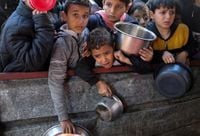In a grim milestone with global repercussions, Gaza has officially been declared in a state of famine, marking the first such declaration in the Middle East and only the fifth worldwide since the inception of modern famine classification systems. The confirmation, announced by the United Nations-backed Integrated Food Security Phase Classification (IPC) on August 22, 2025, comes amid mounting casualties, surging malnutrition rates, and a humanitarian crisis that observers and international agencies say was preventable.
According to the IPC’s latest assessment, more than half a million people—nearly a quarter of Gaza’s population—are now facing catastrophic hunger. The situation is not confined to Gaza City; famine conditions are projected to spread to Deir el-Balah and Khan Younis in the coming weeks, with IPC projections warning that the number of people facing famine could rise to 641,000 by the end of September. The data paints a dire picture: over 1.14 million more are expected to be in the next-worst phase of food insecurity, with a further 396,000 in crisis conditions.
UN Secretary-General Antonio Guterres minced no words in his response, calling the famine “a man-made disaster, a moral indictment – and a failure of humanity itself.” He continued, “Famine is not about food; it is the deliberate collapse of the systems needed for human survival.” Guterres emphasized Israel’s obligations as the occupying power under international law, insisting it must ensure the provision of food and medical supplies to Gaza’s population. “No more excuses. The time for action is not tomorrow – it is now,” he declared, as reported by APP.
On the ground, the reality is even starker. The Gaza Health Ministry reported on August 24, 2025, that 289 Palestinians, including 115 children, have died of starvation amid the ongoing crisis. In just the previous 24 hours, eight more Palestinians—including a child—succumbed to food shortages. Medical sources across the enclave described a relentless stream of casualties, with 64 bodies and 278 injured arriving at hospitals in a single day, many of them victims of Israeli strikes or shootings while seeking food near distribution points.
The humanitarian situation has been compounded by violence at aid distribution sites. Since the Gaza Humanitarian Foundation (GHF) began operations at the end of May 2025, more than 1,000 Palestinians have been killed and thousands more wounded while seeking aid, according to figures cited by the United Nations. Of these, 766 died near GHF aid points and 288 near UN or other convoys. The death toll from aid queues continues to rise, highlighting how the blockade and the GHF’s controversial role have made humanitarian relief both scarce and dangerous. At least five people were shot while waiting for food near GHF-run points, and seven aid seekers were killed in a single 24-hour period.
Despite these harrowing statistics, the United States announced $30 million in funding for the GHF, even as human rights groups accused Israel of using starvation as a weapon. The UN’s Emergency Relief Coordinator Tom Fletcher was blunt in his assessment: “It is a famine that we could have prevented, if we had been allowed. Yet food stacks up at borders because of systematic obstruction by Israel. It is a famine within a few hundred metres of food, in a fertile land.” Fletcher lamented that the famine was “watched over by drones and the most advanced military technology in history,” and accused some Israeli leaders of openly promoting starvation as a weapon of war.
Children are bearing the brunt of the catastrophe. Dr. Ahmed al-Farra, head of the children’s department at Nasser Medical Complex in Khan Younis, warned that the health crisis in southern Gaza had reached “a catastrophic level.” He told Al Jazeera, “One in four children in Gaza is already suffering from malnutrition, and between 60,000 and 75,000 children in southern Gaza alone are at risk.” Dr. al-Farra described scenes of children lying on the floor due to a lack of beds, and some dying outside hospital gates for want of milk and treatment. The malnutrition clinic at Nasser, which operates only two days a week, now receives more than 120 cases within hours—ten times higher than before the crisis.
The United Nations and its agencies have repeatedly called for an immediate ceasefire to allow unimpeded, large-scale humanitarian response and the release of all hostages taken by Hamas and other militants on October 7, 2023. They have also expressed grave concern over the threat of intensified Israeli military operations in Gaza City and the potential for further escalation, which would have “further devastating consequences for civilians where famine conditions already exist.”
The technical definition of famine, as outlined by the IPC, requires three critical thresholds to be breached: extreme food deprivation, acute malnutrition, and starvation-related deaths. In Gaza, all three have been met. UN human rights chief Volker Türk called the famine “the direct result” of Israeli government policies, stating, “It is a war crime to use starvation as a method of warfare, and the resulting deaths may also amount to the war crime of willful killing.” Türk urged Israeli authorities to ensure immediate entry of humanitarian assistance and full access for UN and other humanitarian organizations.
Since October 2023, the Palestinian Health Ministry reports at least 62,686 people have been killed and 157,951 wounded in Gaza due to Israeli attacks. The violence has not abated: Israeli planes and tanks pounded the eastern and northern outskirts of Gaza City overnight from August 23 to 24, 2025, destroying buildings and homes, with residents reporting nonstop explosions in Zeitoun and Shejaia and tanks shelling houses and roads in Sabra. Several buildings were blown up in Jabalia, and the health system, already overwhelmed, continues to struggle with the influx of casualties.
International legal consequences are mounting as well. In November 2024, the International Criminal Court issued arrest warrants for Israeli Prime Minister Benjamin Netanyahu and former Defence Minister Yoav Gallant for alleged war crimes and crimes against humanity in Gaza. Israel also faces a genocide case at the International Court of Justice for its conduct during the conflict.
Meanwhile, the famine’s impact on Gaza’s children is accelerating at what UN agencies call a “catastrophic pace.” In July alone, more than 12,000 children were identified as acutely malnourished—a six-fold increase since the start of the year. The number of children at severe risk of death from malnutrition by June 2026 is projected to triple, from 14,100 to 43,400, according to the latest IPC analysis.
Despite a slight increase in food and aid supplies entering Gaza since July, the amounts remain “vastly insufficient, inconsistent and inaccessible compared to the need,” as the UN notes. Approximately 98 percent of Gaza’s cropland is now damaged or inaccessible, decimating local food production, and nine out of ten people have been displaced from their homes, compounding the crisis.
As the world watches, the question lingers: what will be done, and when? The people of Gaza, especially its children, cannot wait much longer.


